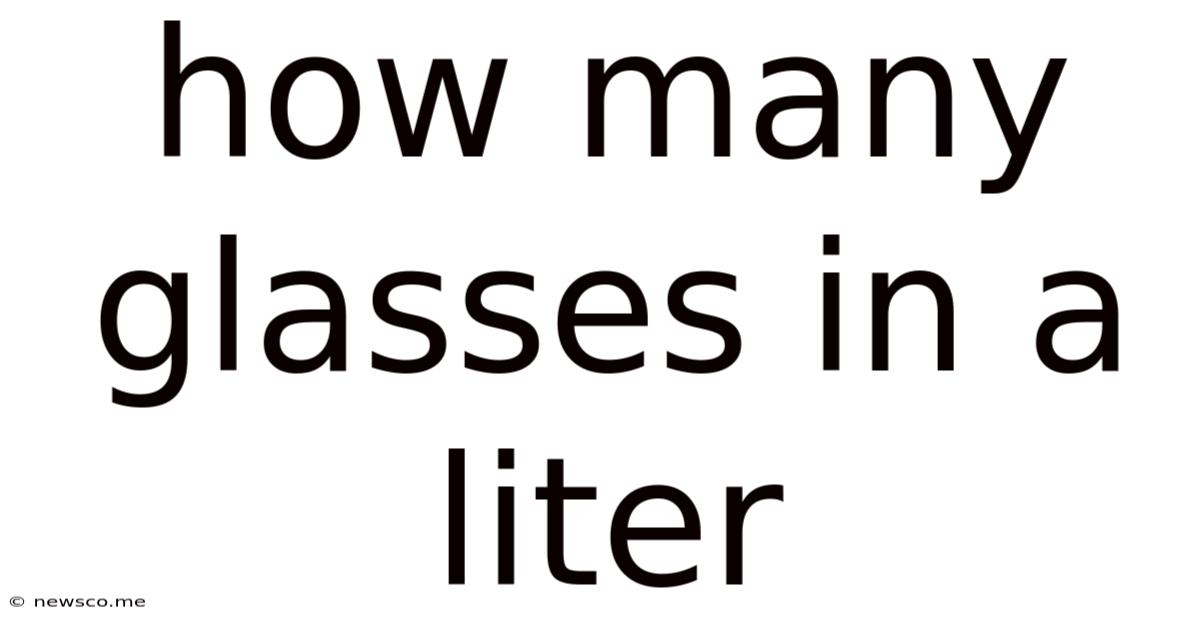How Many Glasses In A Liter
News Co
Mar 15, 2025 · 4 min read

Table of Contents
How Many Glasses in a Liter? A Comprehensive Guide to Volume Conversions
Understanding volume conversions is crucial in various aspects of life, from cooking and baking to scientific experiments and everyday measurements. One common conversion that often sparks confusion is determining how many glasses are in a liter. This comprehensive guide will delve into this query, providing a clear understanding of the conversion, factors influencing variations, and practical applications.
Understanding Liters and Glasses
Before diving into the conversion, let's establish a clear understanding of the units involved:
-
Liter (L): A metric unit of volume, widely used internationally. One liter is equivalent to 1000 cubic centimeters (cm³). It's a standard unit for measuring liquids like water, juice, or milk.
-
Glass: This is less precise. The size of a "glass" varies considerably depending on the type of glass, its intended use, and regional differences. There's no single standard "glass" size. We'll explore this variability further below.
The Approximate Conversion: How Many Glasses in a Liter?
There's no single definitive answer to "how many glasses in a liter?" because of the variable size of a glass. However, a common estimation uses an 8-ounce (oz) glass as a benchmark.
Considering an 8-ounce glass:
- 1 liter is approximately equal to 33.8 fluid ounces (fl oz).
- Dividing 33.8 fl oz by 8 fl oz/glass, we get approximately 4.2 glasses in a liter.
Therefore, as a general rule of thumb, you can consider a liter to contain about 4 glasses. However, this is merely an approximation.
Factors Affecting Glass Size and Volume
The variability in glass size necessitates a closer examination of factors influencing volume:
-
Type of Glass: A juice glass, a wine glass, a pint glass, a water glass – all differ significantly in capacity. A small shot glass will hold far less than a large beer glass.
-
Manufacturer and Design: Even within a specific type of glass (e.g., a water glass), dimensions can vary based on the manufacturer and design. Some manufacturers may produce glasses slightly larger or smaller than others.
-
Regional Differences: Standard glass sizes may differ slightly depending on the region or country. What's considered a standard "glass" in one place might be significantly different elsewhere.
-
Fill Level: The "fullness" of a glass also significantly impacts the volume. A glass filled to the brim holds more than one filled halfway. In recipes or other scenarios, the intended fill level should be specified clearly.
Precision in Measurements: When Accuracy Matters
When precise measurements are critical – for instance, in scientific experiments, pharmaceutical applications, or specific recipes – using a graduated cylinder or other precise measuring tools is essential. Relying on the approximate "4 glasses per liter" conversion in such contexts could lead to significant errors.
Converting Units for Precision
To ensure accuracy, always use standard units like milliliters (ml) or liters (L). If you need to work with glasses, first determine the exact volume capacity of the glass using a measuring jug or other precise measuring tool.
Practical Applications: Using the Liter-to-Glass Conversion
Understanding the approximate conversion can be helpful in many everyday situations:
-
Cooking and Baking: When a recipe calls for a specific liquid volume in liters, you can get a rough estimate using the 4-glass approximation. However, for precision, particularly in baking, using a measuring jug is always recommended.
-
Serving Drinks: If you're serving drinks and know the total volume of liquid in liters, this conversion can help you estimate the number of glasses needed.
-
Household Chores: When determining the amount of cleaning solution required for a specific area, the conversion can provide a helpful estimate.
Beyond the Basics: More Accurate Conversions
While the 4-glass approximation is useful for quick estimations, achieving higher precision involves a multi-step process:
-
Measure Your Glass: Use a measuring jug or other accurate measuring device to determine the exact volume of your glass in milliliters (ml) or fluid ounces (fl oz).
-
Convert to Liters: Convert the volume of your glass to liters (1000 ml = 1 L). If using fluid ounces, convert to liters using the appropriate conversion factor (1 fl oz ≈ 29.57 ml).
-
Calculate the Number of Glasses: Divide the total volume in liters by the volume of your glass in liters to find the exact number of glasses.
Conclusion: Navigating the World of Volume Conversions
Converting liters to glasses involves understanding the inherent variability in glass size. The common approximation of approximately 4 glasses per liter provides a useful estimate for everyday scenarios. However, whenever precision is paramount, using accurate measuring tools and converting units directly is essential to avoid inaccuracies. Remember that this conversion depends heavily on the specific size of the glass being used, making accurate measurement of your glass the most crucial step for obtaining precise results. By considering these factors and employing the appropriate measurement techniques, you can confidently navigate volume conversions in various situations.
Latest Posts
Latest Posts
-
Find The Point On The Y Axis Which Is Equidistant From
May 09, 2025
-
Is 3 4 Bigger Than 7 8
May 09, 2025
-
Which Of These Is Not A Prime Number
May 09, 2025
-
What Is 30 Percent Off Of 80 Dollars
May 09, 2025
-
Are Alternate Exterior Angles Always Congruent
May 09, 2025
Related Post
Thank you for visiting our website which covers about How Many Glasses In A Liter . We hope the information provided has been useful to you. Feel free to contact us if you have any questions or need further assistance. See you next time and don't miss to bookmark.